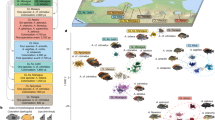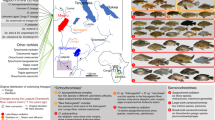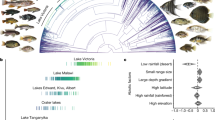Abstract
Arising from: M. Barluenga, K. N. Stölting, W. Salzburger, M. Muschick & A. Meyer Nature 439, 719–723 (2006); Barluenga et al. reply
Sympatric speciation is difficult to demonstrate in nature and remains a hotly debated issue. Barluenga et al.1 present a case of putative sympatric speciation for two cichlid species in the Nicaraguan crater lake Apoyo, but they overlook or reinterpret some key published information on the system. Although sympatric speciation is possible in theory2,3, we show here that, when this information is taken into account, the results of Barluenga et al.1 do not provide conclusive evidence for sympatric speciation: this is because the null hypothesis of multiple invasion with introgression cannot be rejected.
This is a preview of subscription content, access via your institution
Access options
Subscribe to this journal
Receive 51 print issues and online access
$199.00 per year
only $3.90 per issue
Buy this article
- Purchase on Springer Link
- Instant access to full article PDF
Prices may be subject to local taxes which are calculated during checkout

Similar content being viewed by others
References
Barluenga, M., Stölting, K. N., Salzburger, W., Muschick, M. & Meyer, A. Nature 439, 719–723 (2006).
Dieckmann, U., Doebeli, M., Metz, H. & Tautz, D. Adaptive Speciation (Cambridge Univ. Press, Cambridge, UK, 2004).
Gavrilets, S. Fitness Landscapes and the Origin of Species. Monographs in Population Biology 41 (Princeton University Press, Princeton, New Jersey, 2004).
Barluenga, M. & Meyer, A. Mol. Ecol. 13, 2061–2076 (2004).
Taylor, E. B. & McPhail, J. D. Proc. R. Soc. Lond. B 267, 2375–2384 (2000).
Bernatchez, L. et al. Can. J. Fish. Aqu. Sci. 52, 179–185 (1995).
Seehausen, O. Trends Evol. Ecol. 19, 198–207 (2004).
McKaye, K. R. et al. Cuadernos de Investigación de la UCA 12, 19–47 (2002).
Stauffer, J. R. & McKaye, K. R. & Stauffer, J. R. Cuadernos de Investigación de la UCA 12, 1–18 (2002).
Machado, C. A. et al. Mol. Biol. Evol. 19, 472–488 (2002).
Schliewen, U. K. & Klee, B. Front. Zool. 1, doi: 10.1186/1742-9994-1-5 (2004).
Author information
Authors and Affiliations
Corresponding author
Rights and permissions
About this article
Cite this article
Schliewen, U., Kocher, T., McKaye, K. et al. Evidence for sympatric speciation?. Nature 444, E12–E13 (2006). https://doi.org/10.1038/nature05419
Published:
Issue Date:
DOI: https://doi.org/10.1038/nature05419
This article is cited by
-
Inverting the null-hypothesis of speciation: a marine snail perspective
Evolutionary Ecology (2009)
-
Evidence for sympatric speciation? (Reply)
Nature (2006)
Comments
By submitting a comment you agree to abide by our Terms and Community Guidelines. If you find something abusive or that does not comply with our terms or guidelines please flag it as inappropriate.



